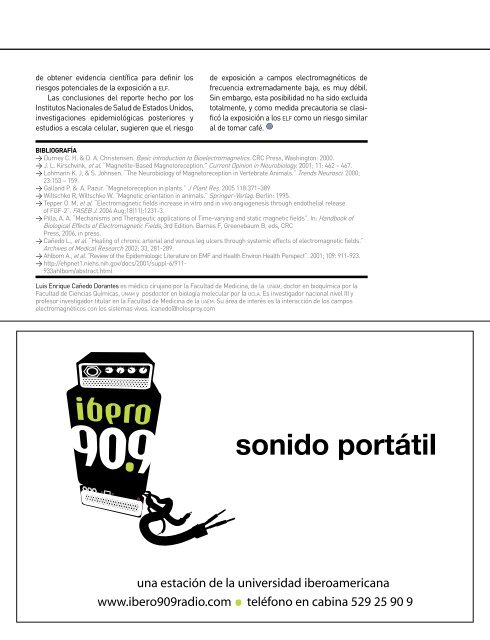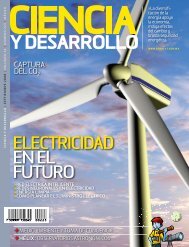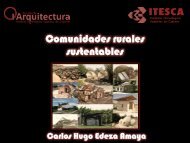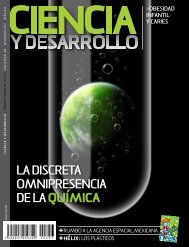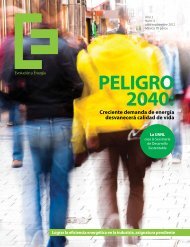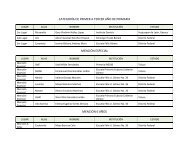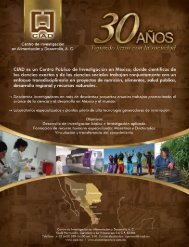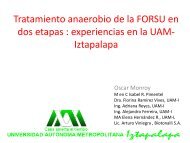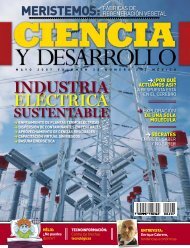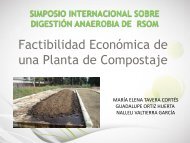Revista Ciencia Y Desarrollo, dic. 2006 - Año Internacional de la ...
Revista Ciencia Y Desarrollo, dic. 2006 - Año Internacional de la ...
Revista Ciencia Y Desarrollo, dic. 2006 - Año Internacional de la ...
- No tags were found...
You also want an ePaper? Increase the reach of your titles
YUMPU automatically turns print PDFs into web optimized ePapers that Google loves.
<strong>de</strong> obtener evi<strong>de</strong>ncia científica para <strong>de</strong>finir los<br />
riesgos potenciales <strong>de</strong> <strong>la</strong> exposición a ELF.<br />
Las conclusiones <strong>de</strong>l reporte hecho por los<br />
Institutos Nacionales <strong>de</strong> Salud <strong>de</strong> Estados Unidos,<br />
investigaciones epi<strong>de</strong>miológicas posteriores y<br />
estudios a esca<strong>la</strong> celu<strong>la</strong>r, sugieren que el riesgo<br />
<strong>de</strong> exposición a campos electromagnéticos <strong>de</strong><br />
frecuencia extremadamente baja, es muy débil.<br />
Sin embargo, esta posibilidad no ha sido excluida<br />
totalmente, y como medida precautoria se c<strong>la</strong>sificó<br />
<strong>la</strong> exposición a los ELF como un riesgo simi<strong>la</strong>r<br />
al <strong>de</strong> tomar café.<br />
BIBLIOGRAFÍA<br />
> Durney C. H. & D. A. Christensen. Basic introduction to Bioelectromagnetics. CRC Press, Washington: 2000.<br />
> J. L. Kirschvink, et al. “Magnetite-Based Magnetoreception.” Current Opinion in Neurobiology. 2001; 11: 462 – 467.<br />
> Lohmann K. J, & S. Johnsen. “The Neurobiology of Magnetoreception in Vertebrate Animals.” Trends Neurosci. 2000;<br />
23:153 – 159.<br />
> Gal<strong>la</strong>nd P. & A. Pazur. “Magnetoreception in p<strong>la</strong>nts.” J P<strong>la</strong>nt Res. 2005 118:371–389<br />
> Wiltschko R, Wiltschko W. “Magnetic orientation in animals.” Springer-Ver<strong>la</strong>g. Berlin: 1995.<br />
> Tepper O. M, et al. “Electromagnetic fields increase in vitro and in vivo angiogenesis through endothelial release<br />
of FGF-2”. FASEB J. 2004 Aug;18(11):1231-3.<br />
> Pil<strong>la</strong>, A. A. “Mechanisms and Therapeutic applications of Time-varying and static magnetic fields”. In: Handbook of<br />
Biological Effects of Electromagnetic Fields, 3rd Edition. Barnes F, Greenebaum B, eds, CRC<br />
Press, <strong>2006</strong>, in press.<br />
> Cañedo L., et al. “Healing of chronic arterial and venous leg ulcers through systemic effects of electromagnetic fields.”<br />
Archives of Me<strong>dic</strong>al Research 2002; 33, 281-289.<br />
> Ahlbom A., et al. “Review of the Epi<strong>de</strong>miologic Literature on EMF and Health Environ Health Perspect”. 2001; 109: 911-923.<br />
> http://ehpnet1.niehs.nih.gov/docs/2001/suppl-6/911-<br />
933ahlbom/abstract.html<br />
Luis Enrique Cañedo Dorantes es mé<strong>dic</strong>o cirujano por <strong>la</strong> Facultad <strong>de</strong> Me<strong>dic</strong>ina, <strong>de</strong> <strong>la</strong> UNAM, doctor en bioquímica por <strong>la</strong><br />
Facultad <strong>de</strong> <strong>Ciencia</strong>s Químicas, UNAM y posdoctor en biología molecu<strong>la</strong>r por <strong>la</strong> UCLA. Es investigador nacional nivel III y<br />
profesor investigador titu<strong>la</strong>r en <strong>la</strong> Facultad <strong>de</strong> Me<strong>dic</strong>ina <strong>de</strong> <strong>la</strong> UAEM. Su área <strong>de</strong> interés es <strong>la</strong> interacción <strong>de</strong> los campos<br />
electromagnéticos con los sistemas vivos. lcanedo@holosproy.com


